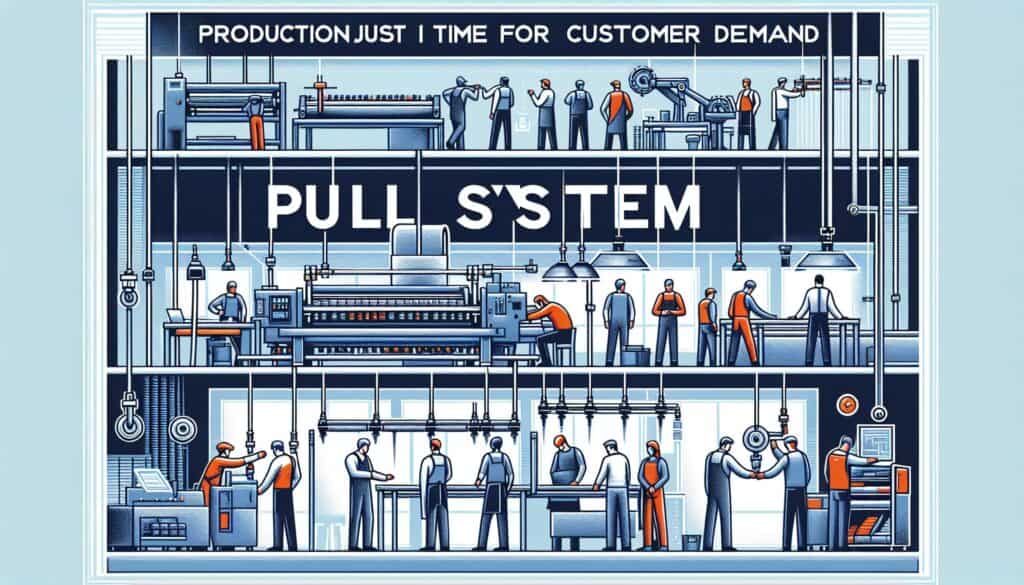Artikel nur dann zu produzieren, wenn sie für den nächsten Prozessschritt oder für den Kunden benötigt werden, um Überproduktion und Lagerbestände zu minimieren.
- Methodologien: Kunden & Marketing, Wirtschaft, Lean Sigma, Herstellung, Projektmanagement, Qualität
Pull-System

Pull-System
- Kontinuierliche Verbesserung, Just-in-Time (JIT), Kanban, Schlanke Fertigung, Prozessverbesserung, Produktionseffizienz, Lieferkette, Wertstrom-Mapping, Strategien zur Abfallbeseitigung
Zielsetzung:
Wie es verwendet wird:
- A Lean manufacturing principle where downstream activities signal their needs to upstream activities. Work is "pulled" through the system based on actual demand, often using tools like Kanban cards.
Vorteile
- Verringert Verschwendung (insbesondere Überproduktion und Lagerbestände); Verbessert die Effizienz der Abläufe und die Reaktionsfähigkeit; Senkt die Lagerkosten; Erhöht die Kundenzufriedenheit durch rechtzeitige Lieferung.
Nachteile
- Für eine optimale Leistung sind zuverlässige Lieferanten und eine stabile Nachfrage erforderlich; kann in komplexen Lieferketten oder bei stark schwankender Nachfrage schwierig umzusetzen sein; erfordert disziplinierte Ausführung und Kommunikation.
Kategorien:
- Lean Sigma, Herstellung
Am besten geeignet für:
- Steuerung des Ressourcenflusses in einem Produktionsprozess, indem nur das ersetzt wird, was verbraucht wurde, und zwar auf der Grundlage der tatsächlichen Kundennachfrage.
The Pull System methodology is prominently utilized in various industries such as automotive, electronics, and consumer goods, where customer demands fluctuate and need accurate synchronization with production processes. This approach is particularly effective during the production phase where ongoing assessment of consumer need dictates the pace of manufacturing, thereby facilitating a more agile response to market changes. Participants in this methodology typically include cross-functional teams that engage in transparent communication, allowing for real-time data sharing and decision-making based on actual consumption rather than forecasts. For example, in the automotive industry, manufacturers often employ Kanban boards to visualize workflow and inventory status, ensuring that components are replenished as they are used, thereby minimizing excess stock and associated carrying costs. By encouraging workers on the assembly line to signal when parts are needed, organizations can ensure that they are only producing what is required by the next step in the process. This not only enhances operational efficiency but also contributes to a culture of continuous improvement where feedback loops inform adjustments in production strategy. Tools such as value stream mapping often accompany the Pull System to identify and eliminate waste, fostering an environment of continuous refinement. Such methodologies have been integral in enhancing customer satisfaction by optimizing lead times and increasing product availability without the burden of overproduction.
Die wichtigsten Schritte dieser Methodik
- Identify the final product and its requirements from customer feedback.
- Map the value stream to visualize processes and identify wasteful practices.
- Define pull signals, such as Kanban cards, to indicate when to produce or move items.
- Implement systems to react to pull signals, adjusting production based on demand.
- Establish limits for work in progress (WIP) to enhance flow control and efficiency.
- Continuously review and refine processes to align with actual customer needs.
- Train all team members on the pull system principles and their applications.
- Encourage proactive communication and feedback between upstream and downstream processes.
Profi-Tipps
- Implement robust visual management techniques to enhance visibility of work in progress and real-time status updates for improved decision-making.
- Regularly analyze lead times and cycle times to identify bottlenecks and continually refine the pull system for optimal performance.
- Encourage cross-functional collaboration to ensure alignment between production and demand signals, enhancing responsiveness and agility.
Verschiedene Methoden lesen und vergleichen, Wir empfehlen die
> Umfassendes Methoden-Repository <
zusammen mit den über 400 anderen Methoden.
Ihre Kommentare zu dieser Methodik oder zusätzliche Informationen sind willkommen auf der Kommentarbereich unten ↓ , sowie alle ingenieursbezogenen Ideen oder Links.
Historischer Kontext
1930
1940
1950
1950
1958
1960
1960
1930
1940
1949
1950
1950
1960
1960
1960
(wenn das Datum nicht bekannt oder nicht relevant ist, z. B. "Strömungsmechanik", wird eine gerundete Schätzung des bemerkenswerten Erscheinens angegeben)















Verwandte Artikel
Fragebögen zu muskuloskelettalen Beschwerden
Multivariate Tests (MVT)
Mehrfache Regressionsanalyse
Motion-Capture-Systeme
MoSCoW-Methode
Moods Median-Test